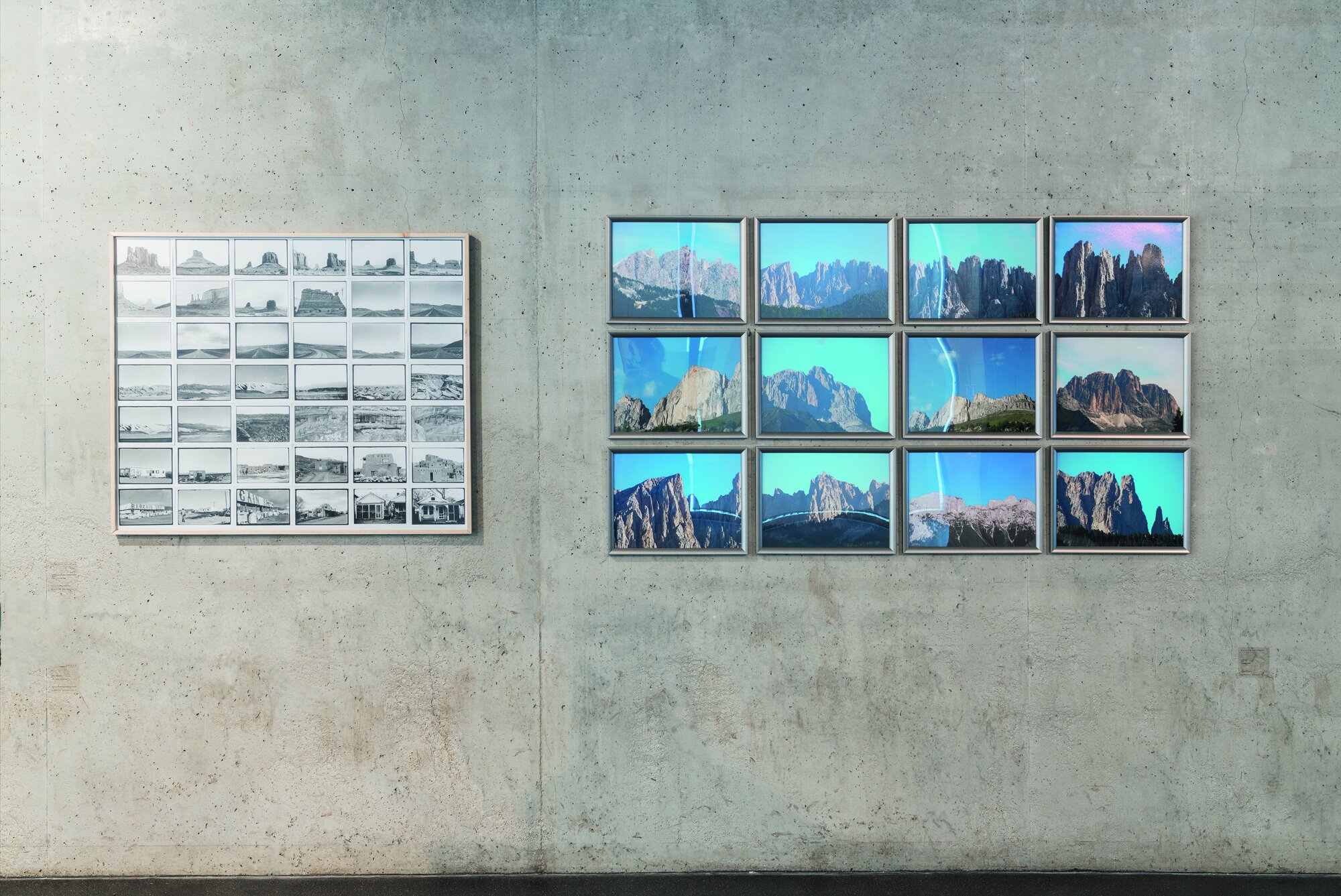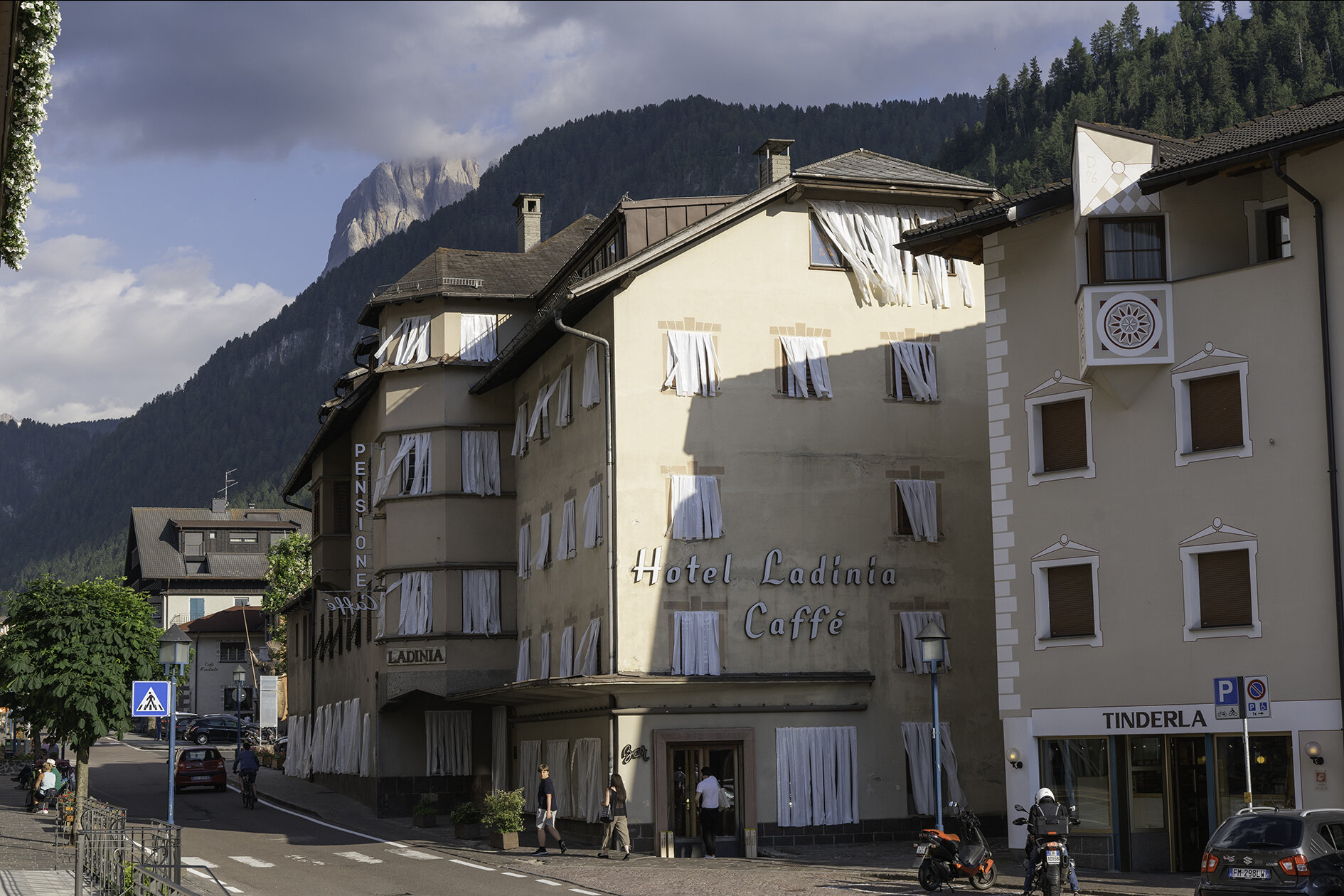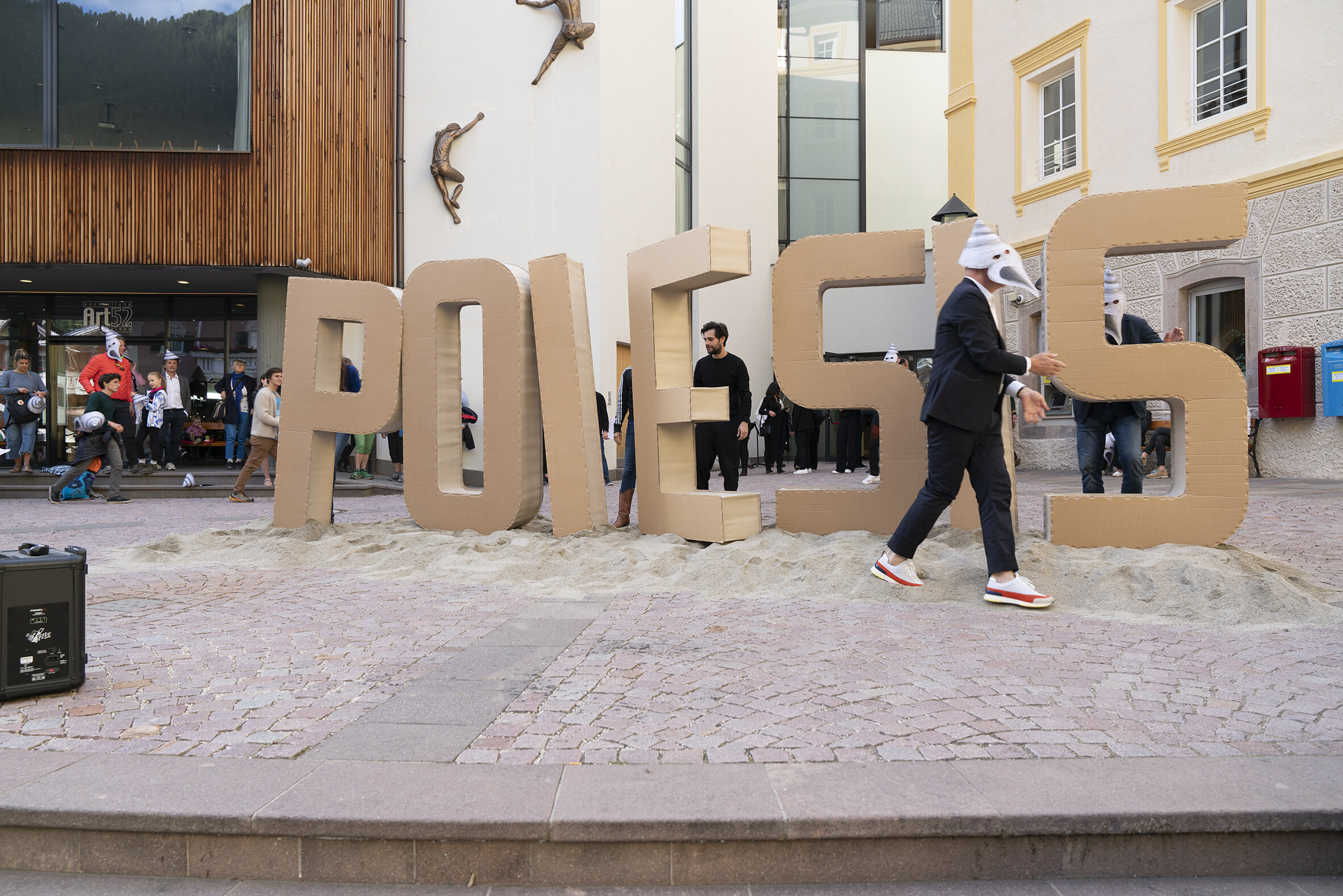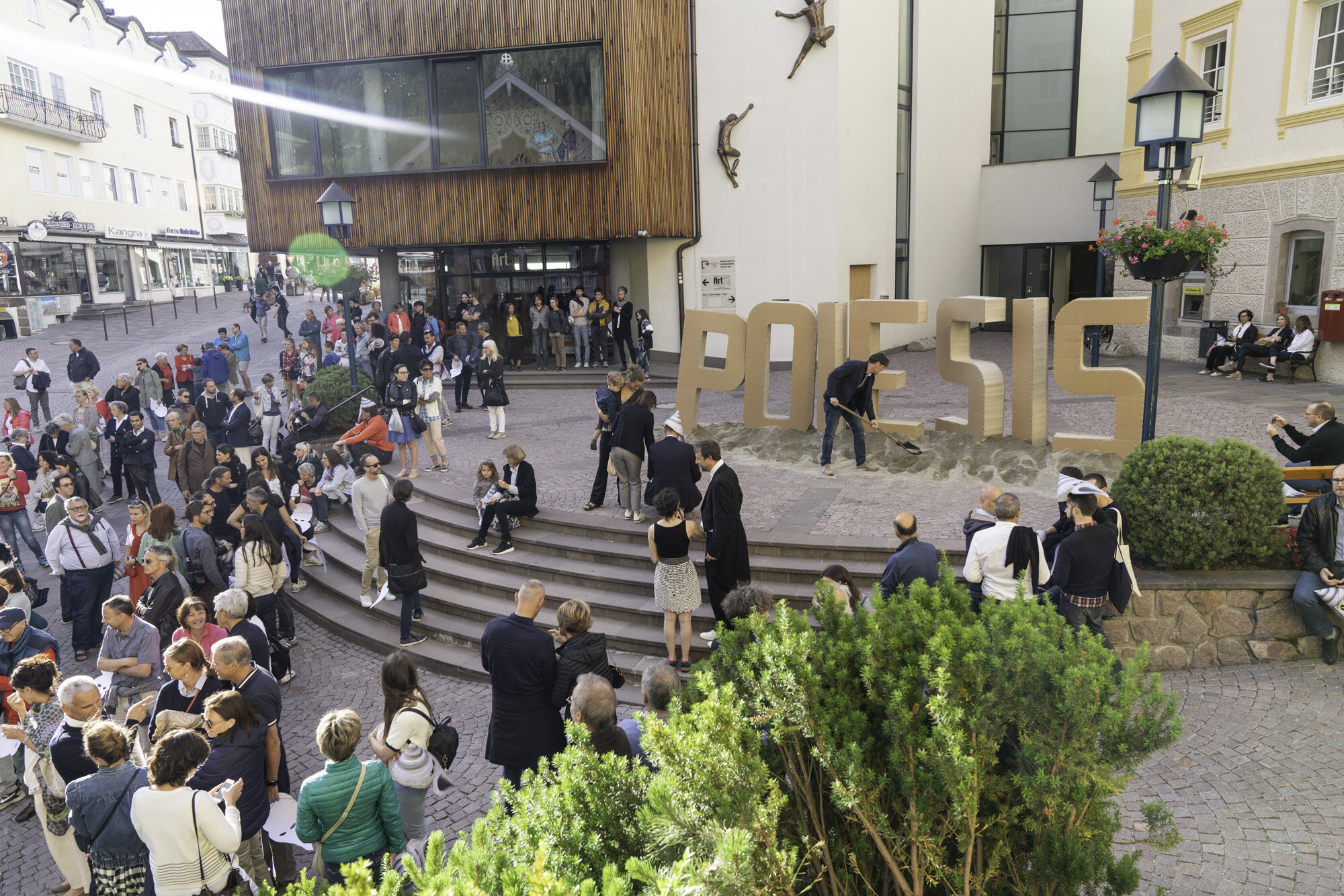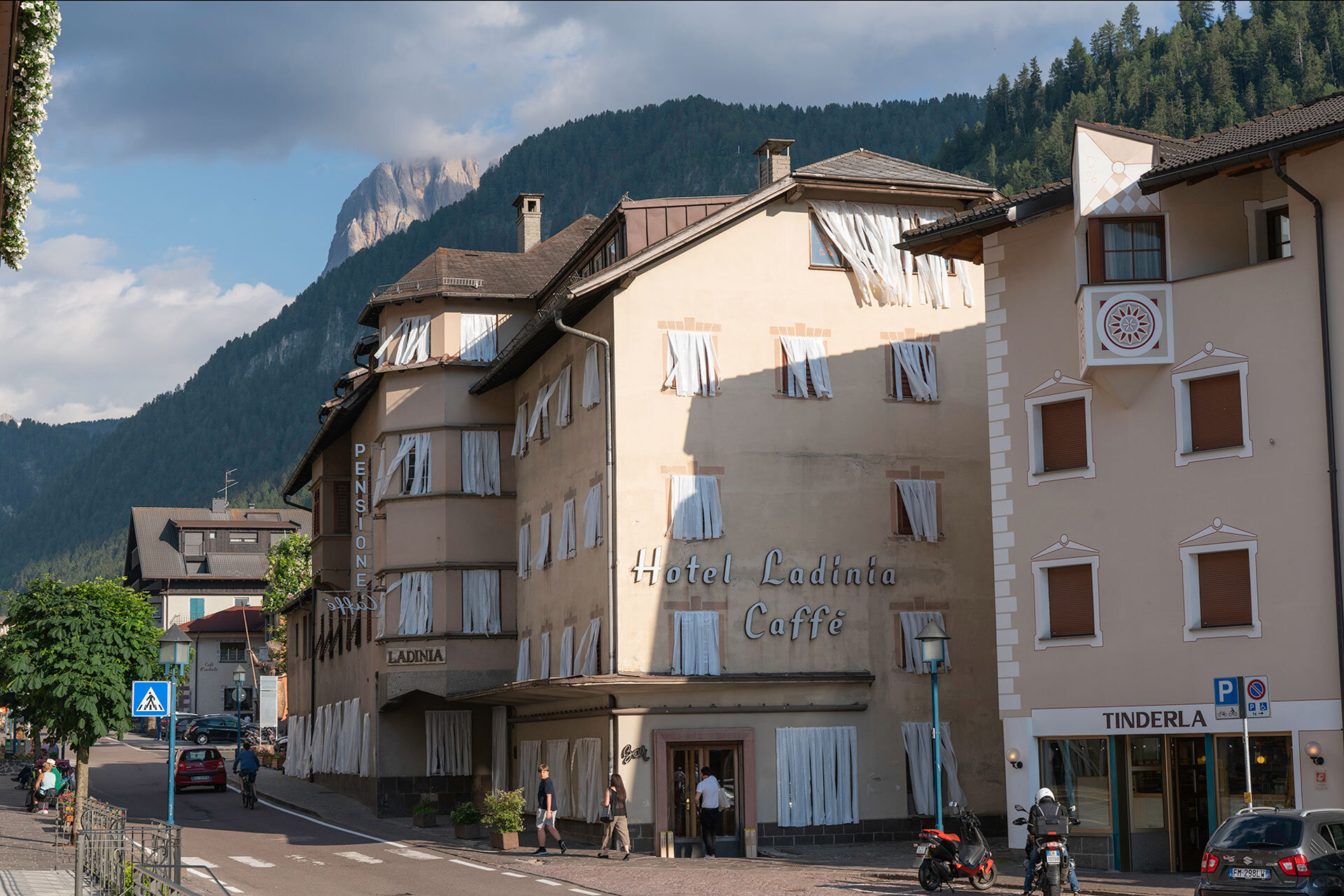
Gianni Pettena
*1940, Italy
lives and works in Florence, Italy
EN
The architectural intervention Hotel Ladinia, conceived in situ, is Pettena’s melancholic attempt at poetic action. Referring semantically back to the architect's projects, conducted in the early 70s and later on too (with the most recent iteration in Frac Lorraine, Metz, 2014), Pettena animates the building whose history was interrupted by the quasi-carnivalesque costume of the multiple stripes of white paper. In fact, the stripes that cover all windows and doors of the long-disused building vertically indicate the intention to revitalize it through lightness and movement, renewing its perception as the language of communication; something which architecture also ought to be, but which instead is often fossilized in imitations and fashionable manners, homogenizing anonymity, absence of vitality.
Gianni Pettena’s performative installation POIESIS, conceived especially for the Biennale Gherdeina, echoes the anarchitect’s radical statements of 1968, expressed in a trilogy of CARABINIERI, performed in the courtyard of Novara’s city hall, MILITE IGNOTO (UNKNOWN SOLDIER) in Ferrara’s Palazzo dei Diamanti and GRAZIA & GIUSTIZIA, presented at the 6th Festival of Avant-Garde Music in Palermo. Pettena’s large-scale installations consisted of a wall of cardboard measuring about ten meters by two in the form of a word; the sheets of corrugated cardboard assembled into three-dimensional shapes with staples, eventually spelling out a statement of a political relevance and urgency. The trilogy held a contextual dialogue with the city, in which words, constructed deliberately out of cardboard, a perishable material, ended up self-destructing. For a radical architect Gianni Pettena, it was a reflection of the desire to transcribe thoughts in terms of slogans, typical of the student revolt in May 1968; the desire, expressed but to no effect, to spell out an ideological position, to signal the intention to take a stand, even as operators in the field of architecture. And so these three inscriptions took on gigantic dimensions, invading the architecture, conversing with the architecture, limiting its meaning. The preexisting architecture just served as a backdrop to the phrase that was in itself a stereotype.
On view in Circolo, there is a series of photographs, About Non-Conscious Architecture, that constitute a sort of catalogue of “works of architecture not made by architects”, discovered in the course of Pettena’s travels in the United States in the early 1970s. The work constitutes a search for a genuine language of architecture; it points out the existence of a “non-conscious” architecture that, by the sole fact of having remained unspoiled or having been constructed in those forms for evident and elementary needs, demands analysis and prompts reflection on the different attitude toward architecture in the European context, or at any rate in that of modern capitalist society. From the mining zone of the Great Salt Lake down to the landscapes of the desert, the wind-formed architecture of Monument Valley, the anarchitect conducts “a journey back to find the threads of a discourse that is no longer very recognizable [because] the harmony, the osmosis with a physical space depends on a multitude of mental habits, or on a disposition that has now been lost.”
IT
L'intervento architettonico Hotel Ladinia, concepito in situ, è un tentativo melanconico da parte di Pettena di intraprendere un’azione poetica. Facendo riferimento semantico a progetti condotti a partire dai primi anni ‘ 70 (l’iterazione più recente è quella di Frac Lorraine, Metz, 2014), Pettena anima l’edificio interrompendone la storia con un costume di strisce multiple di carta bianca. In realtà, le strisce, che coprono tutte le finestre e porte dell’edificio, in disuso da molto tempo, indicano in modo verticale l’intenzione di revitalizzarlo attraverso la leggerezza e il movimento, rinnovandone la percezione come linguaggio della comunicazione. Cioè, qualcosa che l’architettura dovrebbe aspirare a essere, anziché fossilizzarsi, come spesso accade, nell’imitazione, omogenizzando l’anonimato e l’assenza di vitalità.
L’installazione performativa di Gianni Pettena POIESIS, concepita appositamente per la Biennale Gherdëina, ricorda le dichiarazioni radicali dell’ “anarchitetto” del 1968, espresse nella trilogia di CARABINIERI, inscenata nel cortile del municipio di Novara, MILITE IGNOTO presso il Palazzo dei Diamanti di Ferrara e GRAZIA & GIUSTIZIA, presentata in occasione del Sesto Festival di Musica d’Avanguardia di Palermo. Le installazioni su larga scala di Pettena consistevano in pareti-parole in cartone corrugato di 10 metri per 2 in cui, graffettati insieme, i vari fogli creavano forme tridimensionali che esprimevano dichiarazioni di urgenza e rilevanza politica. La trilogia entrava in un dialogo contestuale con la città in cui le parole, costruite volutamente in un materiale deperibile come il cartone, finivano per autodistruggersi. Per un architetto radicale come Gianni Pettena, si trattava di richiamare il desiderio di trascrivere pensieri sotto forma di slogan tipico della rivolta studentesca del maggio 1968. Desiderio, espresso ma senza avere effetto, di dichiarare chiaramente una posizione ideologica e per segnalare l’intenzione, anche da parte degli operatori nel campo dell’architettura, di prendere posizione. E così le tre grandi iscrizioni hanno assunto dimensioni gigantesche, invadendo le architetture, dialogando con esse e limitandone il significato. Le architetture preesistenti, infatti, fungevano solo da sfondo alle frasi stesse che erano per sé stereotipi.
Questa sesta edizione della Biennale Gherdëina rivaluta le opere iconiche concepite da Gianni Pettena nel corso della sua prolifica carriera. Esposta presso il Circolo artistico e culturale, la serie fotografica, Sull’architettura non consapevole, costituisce una sorta di catalogo di “opere di architettura non realizzate da architetti”, scoperte nel corso di viaggi attraverso gli Stati Uniti nei primi anni ’70. L’opera, che costituisce una ricerca dell’autentico linguaggio dell’architettura, sottolinea l’esistenza di un’architettura “non consapevole” che, per il solo fatto di essere rimasta incontaminata oppure costruita in quelle forme per esigenze evidenti ed elementari, richiede di essere analizzata e stimola una riflessione sull’atteggiamento nei confronti dell’architettura nel contesto europeo, o comunque in quello della moderna società capitalista. Dalla zona mineraria del Gran Lago Salato fino ai paesaggi desertici e l’architettura modellata dal vento di Monument Valley, l’“anarchitetto” fa «un viaggio a ritroso per trovare i fili di un discorso che non è più molto riconoscibile [perché] l’armonia, l’osmosi con uno spazio fisico, dipende da una moltitudine di abitudini mentali, o da una disposizione ormai perduta».
DE
Die architektonische Intervention Hotel Ladinia, vor Ort konzipiert, ist Pettenas melancholischer Versuch einer poetischen Aktion. Mit semantischen Anspielungen auf die Projekte des Architekten in den frühen 70ern und später (mit der jüngsten Iteration in Frac Lorraine, Metz 2014) belebt Pettena das Gebäude, dessen Geschichte unterbrochen wurde, mit einem karnevalistisch anmutenden Kostüm aus vielen weißen Papierstreifen. Die vertikalen Streifen bedecken sogar alle Fenster und Türen des lange außer Betrieb stehenden Gebäudes und wecken den Eindruck, als wollten sie es mit Leichtigkeit und Bewegung wieder zum Leben erwecken, als wollten sie seine Wahrnehmung durch die Sprache der Kommunikation erneuern, etwas, was eigentlich Aufgabe von Architektur sein sollte, die stattdessen oft in Nachahmungen und Moden versteinert wird, die Anonymität homegenisieren und die Abwesenheit von Lebendigkeit verkörpern.
Gianni Pettena’s performative installation POIESIS, conceived especially for the Biennale Gherdeina, echoes the anarchitect’s radical statements of 1968, expressed in a trilogy of CARABINIERI, performed in the courtyard of Novara’s city hall, MILITE IGNOTO (UNKNOWN SOLDIER) in Ferrara’s Palazzo dei Diamanti and GRAZIA & GIUSTIZIA, presented at the 6th Festival of Avant-Garde Music in Palermo. Pettena’s large-scale installations consisted of a wall of cardboard measuring about ten meters by two in the form of a word; the sheets of corrugated cardboard assembled into three-dimensional shapes with staples, eventually spelling out a statement of a political relevance and urgency. The trilogy held a contextual dialogue with the city, in which words, constructed deliberately out of cardboard, a perishable material, ended up self-destructing. For a radical architect Gianni Pettena, it was a reflection of the desire to transcribe thoughts in terms of slogans, typical of the student revolt in May 1968; the desire, expressed but to no effect, to spell out an ideological position, to signal the intention to take a stand, even as operators in the field of architecture. And so these three inscriptions took on gigantic dimensions, invading the architecture, conversing with the architecture, limiting its meaning. The preexisting architecture just served as a backdrop to the phrase that was in itself a stereotype.
In Circolo wird die Fotoserie About Non-Conscious Architecture ausgestellt, die eine Art Katalog der „architektonischen Arbeiten, die nicht von Architekten gemacht wurden“ darstellt und die Pettena während seiner Reisen in die USA in den frühen 1970ern erkundete. Die Arbeit stellt die Suche nach einer authentischen Sprache der Architektur dar; sie geht davon aus, dass eine „unbewusste“ Architektur existiert, die, aus dem einfachen Grund heraus, dass sie unverfälscht geblieben ist oder den elementaren Grundbedürfnissen entspricht, einer Analyse bedarf und Reflexion über die verschiedenen Ansätze von Architektur im europäischen Kontext oder überall in der modernen kapitalistischen Gesellschaft auslöst. Von der Bergbauregion am Great Salt Lake bis in die Wüstenlandschaft und die vom Wind geformte Architektur von Monument Valley macht der Anarchitect „eine Reise zurück, um die Enden eines Diskurses zu finden, der nicht mehr besonders sichtbar ist, da die Harmonie, die Osmose mit einem physischen Raum aus einer Vielzahl geistiger Gewohnheiten besteht, oder aus einem verloren gegangenen Temperament.“
